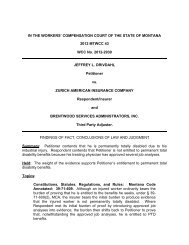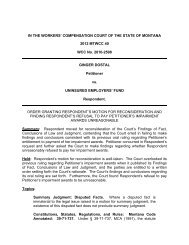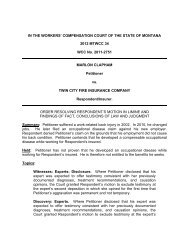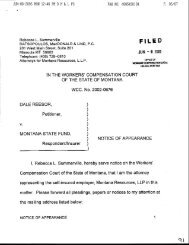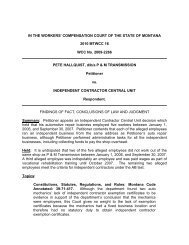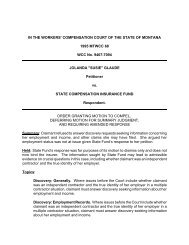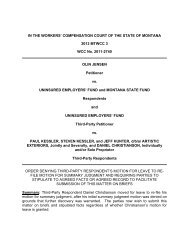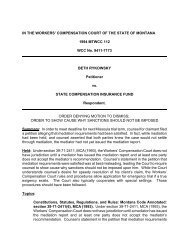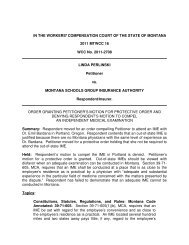Order Granting Respondent's Motion for Summary Judgment
Order Granting Respondent's Motion for Summary Judgment
Order Granting Respondent's Motion for Summary Judgment
- No tags were found...
You also want an ePaper? Increase the reach of your titles
YUMPU automatically turns print PDFs into web optimized ePapers that Google loves.
IN THE WORKERS’ COMPENSATION COURT OF THE STATE OF MONTANA2013 MTWCC 1WCC No. 2012-3021KIM TREVINOPetitionervs.MONTANA STATE FUNDRespondent/Insurer.ORDER GRANTING RESPONDENT’S MOTION FOR SUMMARY JUDGMENTRECONSIDERATION GRANTED – 03/29/13<strong>Summary</strong>: Respondent moved <strong>for</strong> summary judgment on Petitioner’s claim ofentitlement to permanent partial disability and vocational rehabilitation benefits, arguingthat Petitioner was at maximum medical improvement and released to return to hertime-of-injury employment and that Petitioner believes she is capable of per<strong>for</strong>ming hertime-of-injury job. Petitioner objected to Respondent’s motion, arguing that a questionof fact exists as to whether she can per<strong>for</strong>m her time-of-injury job.Held: The undisputed facts support a conclusion that Petitioner is capable ofper<strong>for</strong>ming her time-of-injury job. Thus, she is not entitled to additional permanentpartial disability benefits nor vocational rehabilitation benefits and Respondent is entitledto summary judgment in its favor. 1 Respondent Montana State Fund (State Fund) moves this Court <strong>for</strong> summaryjudgment in its favor. State Fund contends that Petitioner Kim Trevino should notprevail in her claim against State Fund <strong>for</strong> permanent partial disability (PPD) andvocational rehabilitation benefits. 1 Trevino objects to State Fund’s motion, arguing thata genuine issue of fact exists which precludes summary judgment in this matter. 21 <strong>Motion</strong> <strong>for</strong> <strong>Summary</strong> <strong>Judgment</strong> and Brief in Support (Opening Brief), Docket Item No. 11.No. 12.2 Petitioner’s Brief Opposing Respondent’s <strong>Motion</strong> <strong>for</strong> <strong>Summary</strong> <strong>Judgment</strong> (Response Brief), Docket Item
Undisputed Facts 3 2 Trevino worked as an “ironer” at National Laundry. On June 28, 2009, shesuffered an industrial injury to her right shoulder. She filed a workers’ compensationclaim and State Fund accepted liability. 4 3 The ironer job at National Laundry is a physically demanding job, classified asmedium duty, which includes grasping, gripping, reaching, and lifting on a continuousbasis at varying levels. 5 4 Trevino earned $10.20 per hour in her position at National Laundry. 6 5 Trevino last worked <strong>for</strong> National Laundry in July 2011. 7 She was placed ontemporary total disability (TTD) benefits at that time. State Fund terminated those TTDbenefits on March 6, 2012. 8 6 Trevino’s injury was a partial thickness rotator cuff tear on the right, resulting inresidual symptoms of pain and some loss of strength and range of motion. 9 7 On November 21, 2011, Dr. Lawrence Iwerson evaluated Trevino. He opinedthat her right shoulder condition was not surgical. He found her at maximum medicalimprovement (MMI). 10 8 On December 14, 2011, Trevino’s treating physician, Greg Vanichkachorn, M.D.,declared Trevino to be at MMI. He assessed her as having a 1% whole personimpairment rating. 11 9 State Fund has paid Trevino her impairment award. 123 Neither party objected to the other’s proffered facts.4 Opening Brief at 2.5 Response Brief at 2.6 Response Brief at 2.7 Opening Brief at 2.8 Response Brief at 2.9 Response Brief at 2.10 Opening Brief at 2.11 Opening Brief at 2.<strong>Order</strong> <strong>Granting</strong> Respondent’s <strong>Motion</strong> <strong>for</strong> <strong>Summary</strong> <strong>Judgment</strong> – Page 2
10 On January 3, 2012, Trevino underwent a Functional Capacity Evaluation (FCE).The FCE therapist provided conditions <strong>for</strong> Trevino in regard to her time-of-injuryposition, noting, “The concern with this position is the amount and type of reaching shemay have to do with her right arm . . . needs to limit reaching within a range that keepsher elbow close to her body.” 13 However, the therapist did approve the time-of-injuryjob. 14 11 On February 13, 2012, Dr. Vanichkachorn approved Trevino to return to work inher time-of-injury job without restrictions. He also approved job analyses <strong>for</strong> thepositions of ironer catcher, bar towel folder, customer care representative, group homeworker, assembler, motel desk clerk, people greeter, and taxi dispatcher. 15 Thesealternate jobs pay less than Trevino’s time-of-injury job. 16 12 Trevino agrees that she can per<strong>for</strong>m her time-of-injury job. 17 13 After Trevino was released to return to work without restrictions, she asked PhilipMaurer, the production manager at National Laundry, <strong>for</strong> her job back. Maurer told herthat he needed to hear from State Fund’s claims adjuster and told Trevino to wait acouple of weeks to hear back from him. Trevino waited <strong>for</strong> two months, but Maurernever called her back. 18 14 In April 2012, Trevino called Maurer. Maurer told Trevino that National Laundryhad given her ironer position to someone else. However, this statement was untrue andTrevino’s position was vacant at that time. 19 15 In July 2012, National Laundry hired a permanent replacement <strong>for</strong> Trevino’sironer position at National Laundry. 2012 Opening Brief at 2.13 Response Brief at 2-3.14 Reply Brief in Support of State Fund’s <strong>Motion</strong> <strong>for</strong> <strong>Summary</strong> <strong>Judgment</strong> (Reply Brief) at 2.15 Opening Brief at 2.16 Response Brief at 4.17 Opening Brief at 2.18 Response Brief at 3.19 Response Brief at 3.20 Response Brief at 3.<strong>Order</strong> <strong>Granting</strong> Respondent’s <strong>Motion</strong> <strong>for</strong> <strong>Summary</strong> <strong>Judgment</strong> – Page 3
16 Maurer testified that it was “hard to say” if Trevino could per<strong>for</strong>m the ironer jobwith the conditions placed on her by the FCE evaluator. 21 17 Trevino is eligible to be rehired at National Laundry. She recently submitted ajob application to National Laundry, but no positions were available at the time. 22 18 L. Beth Morris, MA, CCRC, is the certified vocational rehabilitation consultantwho per<strong>for</strong>med an employability and wage-loss assessment on Trevino’s file. Morrisconcluded, “Given Ms. Trevino’s ability to return to work within her local labor marketwithout incurring a wage loss, retraining appears neither necessary nor appropriate atthis time.” 23 19 Trevino presently works part-time as a housekeeper at a hotel in Great Falls.She makes $8.25 per hour. 24Analysis and Decision 20 For the Court to grant summary judgment, the moving party must establish thatno genuine issues of material fact exist and that the moving party is entitled to judgmentas a matter of law. 25 Trevino has alleged material facts remain in dispute, as set <strong>for</strong>thbelow. I have determined that the material facts necessary <strong>for</strong> disposition of this caseare undisputed. Accordingly, this case is appropriate <strong>for</strong> summary disposition. 21 This case is governed by the 2007 version of the Montana Workers’Compensation Act since that was the law in effect at the time of Trevino’s industrialaccident. 26 22 In considering State Fund’s motion, I note that summary judgment is an extremeremedy which should not be a substitute <strong>for</strong> a trial on the merits if a material factualcontroversy exists. Moreover, all reasonable inferences which can be drawn from theevidence presented should be drawn in favor of the nonmoving party. 27 Because trials21 Response Brief at 3.22 Opening Brief at 3.23 Opening Brief at 3.24 Response Brief at 4.25 ARM 24.5.329; Farmers Union Mut. Ins. Co. v. Horton, 2003 MT 79, 10, 315 Mont. 43, 67 P.3d 285.26Buckman v. Montana Deaconess Hosp., 224 Mont. 318, 321, 730 P.2d 380, 382 (1986).27 Delaware v. K-Decorators, Inc., 1999 MT 13, 55, 293 Mont. 97, 973 P.2d 818.<strong>Order</strong> <strong>Granting</strong> Respondent’s <strong>Motion</strong> <strong>for</strong> <strong>Summary</strong> <strong>Judgment</strong> – Page 4
in this Court are held on an expedited basis pursuant to ARM 24.5.329(1)(b), summaryjudgment is particularly disfavored in this Court. 28I. Whether this Court should grant summary judgment to State Fund on the issueof Trevino’s entitlement to PPD benefits. 23 Under § 39-71-703, MCA, an injured worker is entitled to PPD benefits if theworker suffers a permanent partial disability and has an actual wage loss as a result ofthe injury. Section 39-71-116(1), MCA, defines “actual wage loss” as “the wages that aworker earns or is qualified to earn after the worker reaches maximum healing are lessthan the actual wages the worker received at the time of the injury.” State Fundcontends that Trevino is not entitled to PPD benefits because she has not suffered awage loss as a result of her industrial injury. 24 In the present case, State Fund notes that it is undisputed that Trevino has beenreleased to return to her time-of-injury job without restriction by her treating physician,and further notes that Trevino herself has testified that she believes she is capable ofper<strong>for</strong>ming her time-of-injury job. 29 State Fund argues that Trevino is presentlyexperiencing a wage loss because she is underemployed and not due to her industrialinjury. 30 25 Trevino responds that issues of material fact exist as to whether her industrialinjury precludes her from per<strong>for</strong>ming her time-of-injury job and whether she has sufferedan actual wage loss as a result of her industrial injury. 31 Specifically, Trevino allegesthat there are “different opinions” as to whether she can per<strong>for</strong>m her time-of-injury job,noting that the FCE evaluator placed limitations on her ability to do the work. Trevinofurther contends that Maurer’s statement that it was “hard to say” whether she couldper<strong>for</strong>m the job constitutes a “different opinion” as to whether she can per<strong>for</strong>m the job. 32Trevino further argues that it is logical to conclude that National Laundry failed to giveher the ironer job back because her <strong>for</strong>mer employer believes she is not capable ofper<strong>for</strong>ming those job duties. 3328 See Oens v. Employee Benefits Ins. Co., 2003 MTWCC 40, 5.29 Opening Brief at 4.30 Opening Brief at 4.31 Response Brief at 4.32 Response Brief at 4.33 Response Brief at 4.<strong>Order</strong> <strong>Granting</strong> Respondent’s <strong>Motion</strong> <strong>for</strong> <strong>Summary</strong> <strong>Judgment</strong> – Page 5
26 As noted above, this Court views summary judgment motions with disfavor. Inthis instance, since State Fund is the moving party, I make all reasonable inferences inTrevino’s favor. As State Fund notes, it is well-established that the definition of actualwage loss encompasses the question of what an individual is qualified to earn, and the“qualified to earn” provision takes into account the possibility that an injured worker maynot immediately return to work after reaching MMI, or may be underemployed. 34 In thepresent case, it is clear that if I conclude that Trevino’s industrial injury has notprecluded her return to her time-of-injury job without restriction, then I must concludeshe has not suffered an “actual wage loss” as she will be qualified to earn her time-ofinjurywage. 27 The facts pertinent to the question of whether Trevino’s industrial injury hasprecluded her from returning to her time-of-injury job as an ironer at National Laundryare as follows:1. Trevino testified that she believes she can per<strong>for</strong>m her time-ofinjuryjob.2. Trevino’s treating physician approved the job analysis <strong>for</strong> Trevino’stime-of-injury job without restriction.3. The FCE therapist expressed concern regarding Trevino’s time-ofinjuryjob, but ultimately approved the job analysis.4. The production manager at National Laundry opined that it was“hard to say” whether Trevino could per<strong>for</strong>m the time-of-injury job. 28 Given the facts set <strong>for</strong>th above, I see no way by which Trevino could prevail onthis issue. Her treating physician, the FCE therapist, and Trevino herself all believe shecan per<strong>for</strong>m her time-of-injury job. Trevino’s supervisor testified, at best, that he did notknow. While Trevino argues that there are “different opinions” which preclude summaryjudgment in this case, even with drawing all inferences in her favor, I cannot concludethat “Yes,” “Yes,” “Yes, although I have concerns,” and “I don’t know” truly constitute“different opinions.” 29 While Trevino further argues that the only possible explanation <strong>for</strong> NationalLaundry’s failure to give her this job back must be because National Laundry does notbelieve she can per<strong>for</strong>m her time-of-injury job duties, I find that the only evidenceTrevino has presented in support of this is her guess that this is the only “logical”conclusion to draw. By engaging in the same sort of speculation as Trevino given the34 Opening Brief at 4; see Masters v. Liberty Northwest Ins. Corp., 2000 MTWCC 1, 37.<strong>Order</strong> <strong>Granting</strong> Respondent’s <strong>Motion</strong> <strong>for</strong> <strong>Summary</strong> <strong>Judgment</strong> – Page 6
same set of facts, I can think of several possible explanations <strong>for</strong> National Laundry’sfailure to give Trevino her job back – some benign, some not. Although Trevino’sspeculation led her to conclude that National Laundry does not think she can per<strong>for</strong>mher time-of-injury job due to her industrial injury, Trevino has not proffered any evidencein support of this speculation and there<strong>for</strong>e I cannot conclude that it constitutes a factualdispute precluding summary judgment. 30 From the evidence be<strong>for</strong>e the Court, I do not see any possible way in whichTrevino can prove that she is precluded from per<strong>for</strong>ming her time-of-injury job and isthere<strong>for</strong>e entitled to PPD benefits. There<strong>for</strong>e, I conclude that State Fund is entitled tosummary judgment in its favor on this issue.II. Whether this Court should grant summary judgment to State Fund on theissue of Trevino’s entitlement to vocational rehabilitation benefits. 31 State Fund further argues that it is entitled to summary judgment on Trevino’sclaim <strong>for</strong> vocational rehabilitation benefits. State Fund notes that, pursuant to § 39-71-1006(1), MCA, an injured worker is eligible <strong>for</strong> rehabilitation benefits if the worker meetsthe definition of disabled worker as provided in § 39-71-1011, MCA, or if the worker has,as a result of the work-related injury, a whole person impairment rating of 15% orgreater. State Fund contends that Trevino does not meet the basic eligibilityrequirements <strong>for</strong> rehabilitation benefits because she is neither a “disabled worker” asthat term is defined in the Workers’ Compensation Act nor does she have a wholeperson impairment rating of 15% or greater. 32 It is undisputed that Trevino received a whole person impairment rating of 1%.There<strong>for</strong>e, the only way in which she would be eligible <strong>for</strong> rehabilitation benefits under§ 39-71-1006, MCA, is if she meets the definition of disabled worker as provided in §39-71-1011(2), MCA, which states:“Disabled worker” means a worker who has a permanent impairment,established by objective medical findings, resulting from a work-relatedinjury that precludes the worker from returning to the job the worker heldat the time of the injury or to a job with similar physical requirements andwho has an actual wage loss as a result of the injury. 33 Trevino argues that, if this Court determines that she cannot per<strong>for</strong>m her time-ofinjuryjob as an ironer at National Laundry, then she would qualify as a “disabledworker” under the applicable statutes. 35 As set <strong>for</strong>th above, I have not made such adetermination. There<strong>for</strong>e, I further conclude that Trevino is not a “disabled worker” as35 Response Brief at 6.<strong>Order</strong> <strong>Granting</strong> Respondent’s <strong>Motion</strong> <strong>for</strong> <strong>Summary</strong> <strong>Judgment</strong> – Page 7
that term is defined in § 39-71-1011(2), MCA. Since Trevino does not have animpairment rating of 15% or greater and does not meet the statutory definition of beinga “disabled worker,” she is not entitled to vocational rehabilitation benefits under § 39-71-1006, MCA. State Fund is there<strong>for</strong>e entitled to summary judgment on this issue.III. Whether this Court should grant summary judgment to State Fund on theissues of Trevino’s entitlement to her costs, attorney fees, and a penalty. 34 State Fund further argues that it is entitled to summary judgment on the issues ofwhether Trevino is entitled to her costs, attorney fees, and a penalty against State Fundunder the applicable statutes. 36 State Fund argues that under §§ 39-71-611, -2907,MCA, this recovery would only be available to Trevino if she prevailed in her otherclaims. 37 Trevino does not dispute this to be the case, and indeed the language of theapplicable statutes does not support recovery of these items unless a claimant prevailson the underlying issue. Since I have determined that State Fund is entitled tosummary judgment in its favor on the issues of Trevino’s entitlement to PPD andvocational rehabilitation benefits, I further conclude that State Fund is entitled tosummary judgment in its favor on these remaining issues since Trevino is not theprevailing party.<strong>Order</strong> 35 Respondent’s motion <strong>for</strong> summary judgment is GRANTED. 36 Pursuant to ARM 24.5.348(2), this <strong>Judgment</strong> is certified as final and, <strong>for</strong>purposes of appeal, shall be considered as a notice of entry of judgment.DATED in Helena, Montana, this 23 rd day of January, 2013.(SEAL)/s/ JAMES JEREMIAH SHEAJUDGEc: Richard J. MartinKevin BraunSubmitted: January 15, 201336 Opening Brief at 2.37 Opening Brief at 6.<strong>Order</strong> <strong>Granting</strong> Respondent’s <strong>Motion</strong> <strong>for</strong> <strong>Summary</strong> <strong>Judgment</strong> – Page 8


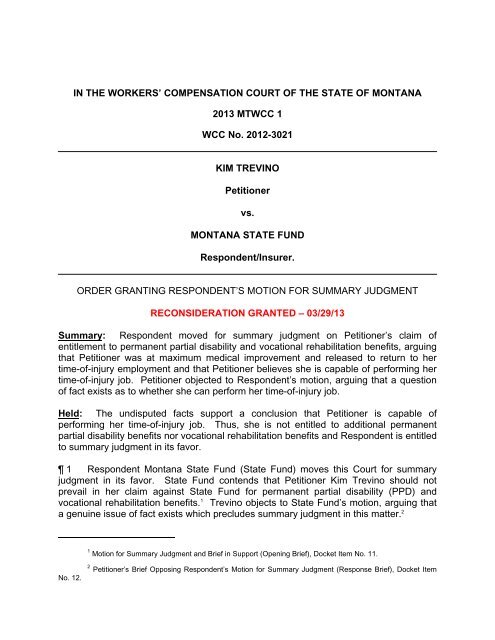
![Bustell v. AIG Claims Service, Inc. [05/03/05] 2005 MTWCC 23](https://img.yumpu.com/49777654/1/190x245/bustell-v-aig-claims-service-inc-05-03-05-2005-mtwcc-23.jpg?quality=85)
![Vallance v. MCCF [07/05/06] 2006 MTWCC 26 - Workers ...](https://img.yumpu.com/48724322/1/190x245/vallance-v-mccf-07-05-06-2006-mtwcc-26-workers-.jpg?quality=85)
